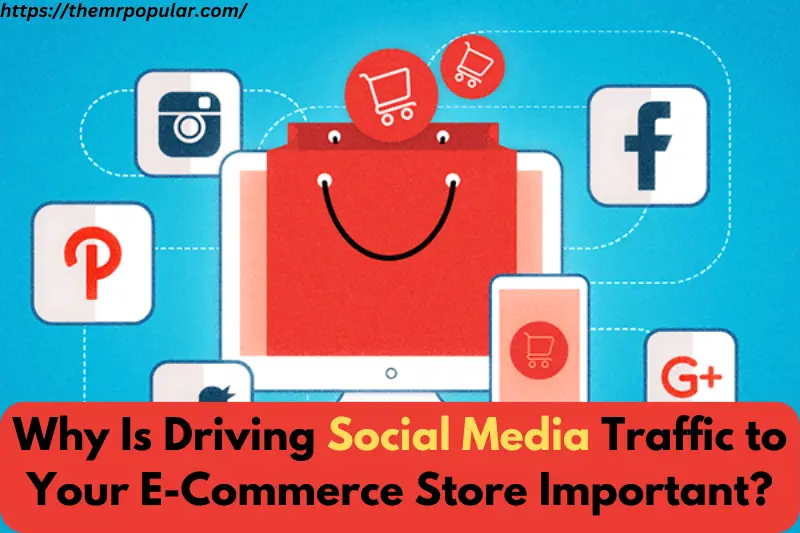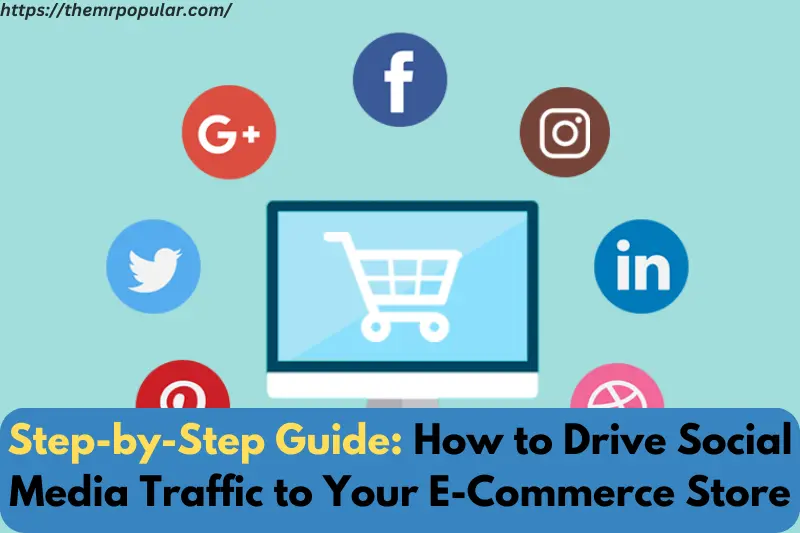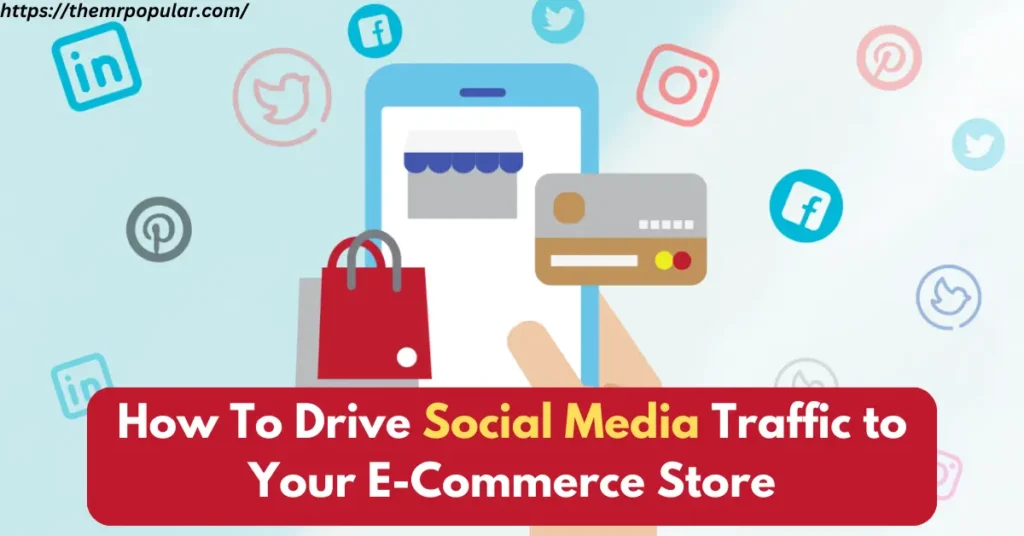Introduction
In today’s digital world, having an online store isn’t enough—you need visitors to turn your products into profits. That’s where social media comes in! Platforms like Facebook, Instagram, Pinterest, and Twitter are more than just places to connect with friends; they’re powerful tools to drive social media traffic to your e-commerce store.
Whether you’re a small business owner or running a large online shop, social media can help you reach the right audience, boost brand awareness, and increase sales. This guide will show you how to use social media effectively to attract visitors to your store and grow your business.
Let’s dive into proven tips and strategies to maximize social media traffic to your e-commerce store and turn your followers into loyal customers!
What is “How to Drive Social Media Traffic to Your E-Commerce Store”?
How to Drive Social Media Traffic to Your E-Commerce Store refers to the strategies and techniques used to attract visitors from social media platforms like Facebook, Instagram, TikTok, Pinterest, and Twitter to your online store. These methods focus on increasing visibility, engaging your target audience, and encouraging them to explore your products and services through your e-commerce site.
Social media platforms are bustling with potential customers, making them the perfect channels to promote your store. By implementing proven practices like creating engaging content, using paid ads, leveraging influencer partnerships, and hosting giveaways, businesses can significantly boost the flow of social media traffic to their e-commerce store.
This concept is all about turning casual scrollers into interested visitors and, eventually, paying customers. By consistently driving social media traffic, you not only increase your sales but also build a loyal community of followers who support your brand.
If you’re looking to grow your e-commerce business, mastering the art of driving social media traffic to your e-commerce store is essential. Keep reading to discover the best strategies to make this happen!
Why Is Driving Social Media Traffic to Your E-Commerce Store Important?

In today’s competitive e-commerce landscape, relying solely on organic search or traditional marketing isn’t enough. Social media serves as a bridge to connect your store with a broader audience, giving your brand visibility and helping you convert potential customers into buyers. Here are the key reasons why driving social media traffic to your e-commerce store is crucial:
Increases Brand Visibility
- Social media platforms have millions of active users every day.
- Sharing your content regularly helps your store stay top of mind.
- It allows your brand to reach new audiences through shares and engagement.
Boosts Website Traffic
- Platforms like Instagram, Facebook, and Pinterest are excellent tools to direct users to your store.
- High traffic increases the chances of making sales and improving your store’s search engine ranking.
Builds Customer Trust and Credibility
- Engaging with customers through social media creates trust in your brand.
- Sharing testimonials, reviews, and success stories builds confidence in your products.
Generates More Sales Opportunities
- Social media introduces your products to potential buyers who might not have found you otherwise.
- Features like shoppable posts and direct ads make it easy for users to purchase with a few clicks.
Encourages Long-Term Customer Relationships
- Social media lets you connect with customers beyond just selling.
- Regular updates, engaging posts, and customer support foster loyalty and repeat purchases.
Cost-Effective Marketing
- Organic posts and user-generated content reduce advertising costs.
- Even with a small budget, paid ads can generate significant traffic and conversions.
Step-by-Step Guide: How to Drive Social Media Traffic to Your E-Commerce Store

Driving social media traffic to your e-commerce store doesn’t have to be complicated. With the right strategy and consistent efforts, you can attract more visitors and turn them into loyal customers. Follow this step-by-step guide to get started:
Step 1: Optimize Your Social Media Profiles
Your social media profiles are like the front door to your brand. Make sure they’re inviting and informative.
- Use a clear profile picture, like your brand logo.
- Add your e-commerce store link in your bio or website section.
- Write a catchy and engaging bio with a call-to-action (CTA) like “Shop Now” or “Explore Our Collection.”
Step 2: Understand Your Target Audience
Knowing who your ideal customers are will help you create content that resonates with them.
- Research their interests, demographics, and preferred platforms.
- Use tools like Facebook Audience Insights or Instagram Analytics to gather data.
Step 3: Post Engaging and Relevant Content
Content is king on social media. Share posts that grab attention and encourage interaction.
- High-quality product photos and videos.
- Behind-the-scenes glimpses of your business.
- Tutorials or how-to guides featuring your products.
Step 4: Use Shoppable Features
Make it easy for users to shop directly from your social media posts.
- Tag products in your Instagram posts and stories.
- Create Pinterest boards with product links.
- Enable Facebook Shops for a seamless shopping experience.
Step 5: Collaborate with Influencers
Influencers can help you reach a larger, engaged audience.
- Choose influencers who align with your brand and niche.
- Offer free products or commissions for promoting your store.
- Encourage them to share your store link or a discount code.
Step 6: Run Social Media Ads
Paid ads are an effective way to reach potential customers.
- Use Facebook and Instagram ads to target specific demographics.
- Create retargeting ads for users who visited your store but didn’t make a purchase.
- Experiment with carousel ads to showcase multiple products.
Step 7: Host Contests and Giveaways
Boost engagement and drive traffic by hosting fun contests.
- Ask participants to follow your page, tag friends, and visit your store.
- Offer an exciting prize, like a popular product or discount code.
Step 8: Engage with Your Audience
Social media is a two-way street. Build relationships with your followers.
- Respond to comments and messages promptly.
- Encourage user-generated content (UGC) by asking customers to share photos of your products.
- Join relevant conversations and trending hashtags in your niche.
Step 9: Leverage Analytics
Track your progress to understand what’s working and what needs improvement.
- Use Instagram Insights, Facebook Analytics, or Google Analytics to monitor traffic and conversions.
- Focus on metrics like click-through rates (CTR), engagement, and sales.
Step 10: Stay Consistent
Consistency is key to growing your audience and driving traffic.
- Post regularly according to your audience’s peak activity times.
- Use a content calendar to plan and schedule your posts.
- Keep your branding uniform across all platforms.
Read More:
The Rise of Short-Form Content TikTok, Instagram Reels, and YouTube Shorts
How to Create Engaging Social Media Content Ideas Without a Big Budget
How AI is Shaping the Future of Social Media Marketing
Best Ways to Buy LinkedIn Followers Safely
Advantages and Disadvantages of Driving Social Media Traffic to Your E-Commerce Store
Social media is a powerful tool for boosting traffic to your online store, but like any strategy, it has its own advantages and disadvantages. Understanding both sides can help you optimize your efforts and avoid potential pitfalls.
| Advantages |
| Boosts Sales and Conversions Effective social media campaigns can directly lead to higher product sales and conversions, |
| Access to Analytics and Insights Social media platforms provide detailed analytics to help you understand your audience’s preferences and behaviors. |
| Opportunities for Viral Marketing Creative content can go viral, significantly increasing your store’s visibility and sales potential. |
| Higher Website Traffic Features like shoppable posts, clickable links, and promotions drive visitors directly to your store. More traffic can lead to better search engine rankings. |
| Improved Customer Engagement Social media allows direct interaction with your audience through comments, messages, and live sessions. Building relationships increases customer trust and loyalty. |
| Cost-Effective Marketing Organic posts, user-generated content, and collaborations with influencers are affordable ways to promote your store. Paid ads offer precise targeting, giving you a high return on investment (ROI). |
| Increased Brand Visibility Social media helps you reach a larger audience. Platforms like Instagram and Facebook expose your store to millions of users daily. |
| Disadvantages |
| Costs Can Escalate While organic strategies are cost-effective, running ads or working with influencers can become expensive if not managed well. |
| Dependence on Platform Policies Your success is partly dependent on the policies of social media platforms, which may change over time. Issues like account suspensions or ad disapprovals can disrupt your efforts. |
| Risk of Negative Feedback Social media is public, and dissatisfied customers can leave negative comments or reviews that may affect your reputation. Handling criticism professionally is crucial. |
| Requires Constant Adaptation Trends and user preferences evolve quickly, requiring you to update your strategy frequently. Staying relevant demands creativity and continuous learning. |
| Unpredictable Algorithm Changes Social media platforms often change their algorithms, which can impact your organic reach and engagement. Businesses may need to invest more in paid ads to maintain visibility. |
| High Competition Every e-commerce store is vying for attention, making it harder to stand out. Without a unique strategy, your store might get lost in the noise. |
| Time-Consuming Managing social media profiles, creating content, and responding to customers require consistent effort and time. Small businesses may struggle without dedicated resources. |
Bonus Tips for Driving Social Media Traffic to Your E-Commerce Store
To give your strategy an extra boost, here are some bonus tips to maximize social media traffic to your e-commerce store:
Utilize Hashtags Strategically
- Research trending and niche-specific hashtags relevant to your business.
- Mix popular and less competitive hashtags for better reach.
- Create a branded hashtag to encourage user-generated content.
Share Customer Reviews and Testimonials
- Highlight positive feedback from happy customers to build trust.
- Use visuals like photos or videos of customers using your products.
- Encourage customers to leave reviews and tag your social media handles.
Collaborate with Micro-Influencers
- Micro-influencers have highly engaged followers and are often more cost-effective than big influencers.
- Partner with them for authentic promotions and product reviews.
Leverage User-Generated Content (UGC)
- Share posts or stories created by your customers.
- UGC acts as social proof and increases trust among potential buyers.
- Create campaigns encouraging customers to share their experiences with your products.
Host Social Media Takeovers
- Let influencers or industry experts take over your account for a day.
- This brings their audience to your page, increasing exposure and traffic.
Repurpose Content Across Platforms
- Use a single piece of content in multiple formats (e.g., turn a blog post into Instagram carousel posts or short TikTok videos).
- Repurposing ensures consistent messaging while saving time.
Run Limited-Time Offers or Flash Sales
- Promote exclusive deals on your social media to create urgency.
- Use countdown timers in stories or posts to grab attention.
Use Chatbots for Quick Engagement
- Automate responses to common customer queries through Facebook Messenger or Instagram DMs.
- Guide users to your e-commerce store through personalized chatbot responses.
Create Interactive Content
- Use polls, quizzes, or Q&A sessions to engage your audience.
- Interactive content increases engagement, which boosts your visibility and drives traffic.
Share Behind-the-Scenes Content
- Showcase the process of creating your products or running your business.
- Behind-the-scenes posts humanize your brand and foster a deeper connection with your audience.
Conclusion
Driving social media traffic to your e-commerce store is one of the best ways to grow your business. By optimizing your profiles, creating engaging content, leveraging shoppable features, and staying consistent, you can attract more visitors and boost your sales. Remember to engage with your audience, track your progress, and adapt to new trends for long-term success. Start applying these tips today and watch your store thrive!
For more helpful tips, visit Technical Dhiraj!
